
Paestan vase painting was a style of vase painting associated with Paestum, a Campanian city in Italy founded by Greek colonists of Magna Graecia. Paestan vase painting is one of five regional styles of South Italian red-figure vase painting.

Paestan vase painting was a style of vase painting associated with Paestum, a Campanian city in Italy founded by Greek colonists of Magna Graecia. Paestan vase painting is one of five regional styles of South Italian red-figure vase painting.
The Paestan vase painting style was originated by Sicilian immigrants around 360 BC, and was the last of the South Italian styles to develop. The first workshop was controlled by Asteas and Python, who are the only South Italian vase painters known from inscriptions. They mainly painted bell kraters, neck amphorae, hydriai , lebes gamikos , lekanes , lekythoi and jugs, more rarely pelikes , chalice kraters, and volute kraters.
Asteas and Python had a major influence on the vase painting of Paestum, clearly visible in the work of the Aphrodite Painter, a likely immigrant from Apulia. Around 330 BC, a second workshop developed, based on the work of the first. The quality of its painting and variety of its motifs deteriorated quickly. At the same time, an influence by the Campanian Caivano Painter becomes notable, with garments falling in a linear fashion and contourless female figures. Around 300 BC, Paestan vase painting came to a halt. [1]

Characteristics of the Paestan style include decorations such as lateral palmettes, a pattern of tendrils with calyx and umbrel known as "Asteas flower", crenelation-like patterns on garments, and curly hair hanging over the back of figures. Figures that bend forwards, resting on plants or rocks, are equally common. Special colours are used often, especially white, gold, black, purple and shades of red. [2]
The themes depicted often belong to the Dionysiac cycle: thiasos and symposium scenes, satyrs, maenads, Silenos, Orestes, Electra, the gods Aphrodite and Eros, Apollo, Athena and Hermes. Paestan painting rarely depicts domestic scenes, but favours animals.

Black-figure pottery painting, also known as the black-figure style or black-figure ceramic, is one of the styles of painting on antique Greek vases. It was especially common between the 7th and 5th centuries BCE, although there are specimens dating as late as the 2nd century BCE. Stylistically it can be distinguished from the preceding orientalizing period and the subsequent red-figure pottery style.

Red-figure pottery is a style of ancient Greek pottery in which the background of the pottery is painted black while the figures and details are left in the natural red or orange color of the clay.
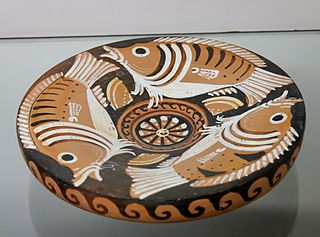
A fish plate is a Greek pottery vessel used by western, Hellenistic Greeks during the fourth century BC. Although invented in fifth-century BC Athens, most of the corpus of surviving painted fish plates originate in Southern Italy, where fourth-century BC Greek settlers, called "Italiotes," manufactured them.
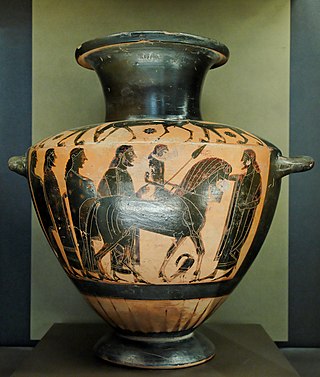
Lydos was an Attic vase painter in the black-figure style. Active between about 560 and 540 BC, he was the main representative of the '’’Lydos Group’’’. His signature, ό Λυδός, ho Lydos ", inscribed on two vases, is informative regarding the cultural background of the artist. Either he immigrated to Athens from the Lydian empire of King Kroisos, or he was born in Athens as the son of Lydian parents. In any case, he learned his trade in Athens.

The Kerch style, also referred to as Kerch vases, is an archaeological term describing vases from the final phase of Attic red-figure pottery production. Their exact chronology remains problematic, but they are generally assumed to have been produced roughly between 375 and 330/20 BC. The style is characterized by slender mannered figures and a polychromatism given to it by the use of white paint and gilding.

Asteas was one of the more active ancient Greek vase painters in Magna Graecia, practicing the red-figure style. He managed a large workshop, in which above all hydriai and kraters were painted. He painted mostly mythological and theatrical scenes. He is one of the few vase painters of the Greek colonies whose name comes down to us.

South Italian is a designation for ancient Greek pottery fabricated in Magna Graecia largely during the 4th century BC. The fact that Greek Southern Italy produced its own red-figure pottery as early as the end of the 5th century BC was first established by Adolf Furtwaengler in 1893. Prior to that this pottery had been first designated as "Etruscan" and then as "Attic." Archaeological proof that this pottery was actually being produced in South Italy first came in 1973 when a workshop and kilns with misfirings and broken wares was first excavated at Metaponto, proving that the Amykos Painter was located there rather than in Athens.

The Sisyphus Painter was an Apulian red-figure vase painter. His works are dated to the last two decades of the fifth century and the very early fourth century BC.

The Ilioupersis Painter was an Apulian vase painter. His works are dated to the second quarter of the 4th century BC.
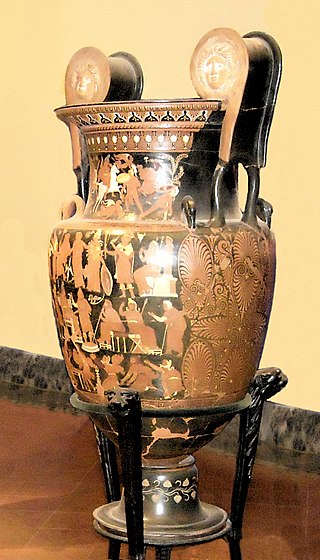
The Darius Painter was an Apulian vase painter and the most eminent representative at the end of the "Ornate Style" in South Italian red-figure vase painting in Magna Graecia. His works were produced between 340 and 320 BC.
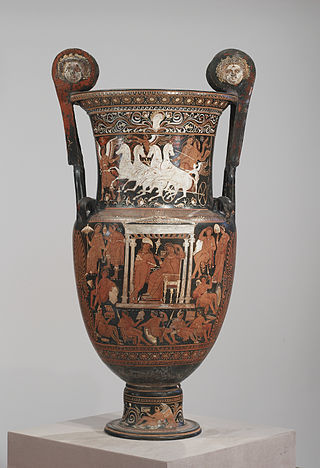
The Baltimore Painter was an Apulian vase painter whose works date to the final quarter of the 4th century BC. He is considered the most important Late Apulian vase painter, and the last Apulian painter of importance. His conventional name is derived from a vase kept at the Walters Art Museum in Baltimore.

The Varrese Painter was an Apulian red-figure vase painter. His works are dated to the middle of the 4th century BC.
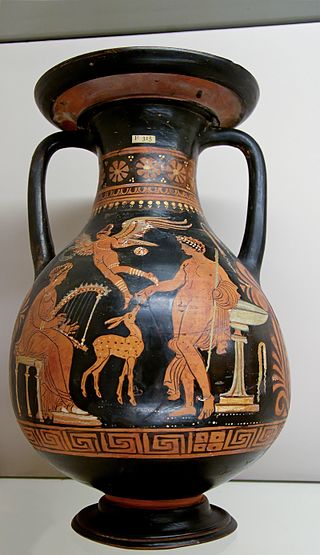
Apulian vase painting was a regional style of South Italian vase painting from ancient Apulia in Magna Graecia. It comprises geometric pottery and red-figure pottery.

The Pisticci Painter was a vase painter who lived in the second half of the 5th century BC. Many of his artistic works were discovered in Pisticci, a small town a few kilometers from Metaponto, Lucania, Italy.

Etruscan vase painting was produced from the 7th through the 4th centuries BC, and is a major element in Etruscan art. It was strongly influenced by Greek vase painting, and followed the main trends in style over the period. Besides being producers in their own right, the Etruscans were the main export market for Greek pottery outside Greece, and some Greek painters probably moved to Etruria, where richly decorated vases were a standard element of grave inventories.

Sicilian vase painting was a regional style of South Italian red-figure vase painting fabricated in Magna Graecia. It was one of five South Italian regional styles. The vase painting of Sicily was especially closely connected with the Lucanian and Paestan styles.

Gnathia vases are a type of pottery belonging to ancient Apulian vase painting of the 4th century BC.

Campanian vase painting is one of the five regional styles of South Italian red-figure vase painting fabricated in Magna Graecia. It forms a close stylistic community with Apulian vase painting.
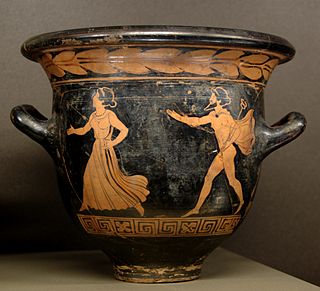
Lucanian vase painting was substyle of South Italian red-figure vase painting fabricated in Magna Graecia, produced in Lucania between 450 and 325 BC. It was the oldest South Italian regional style. Together with Sicilian and Paestan vase painting, it formed a close stylistic community.

Python was a Greek vase painter in the city of Poseidonia in Campania, Southern Italy, one of the major cities of Magna Graecia in the fourth Century BC. Together with his close collaborator and likely master Asteas, Python is one of only two vase painters from Southern Italy whose names have survived on extant works. It has even been suggested that the joint workshop of Asteas and Python in Paestum was a family business.